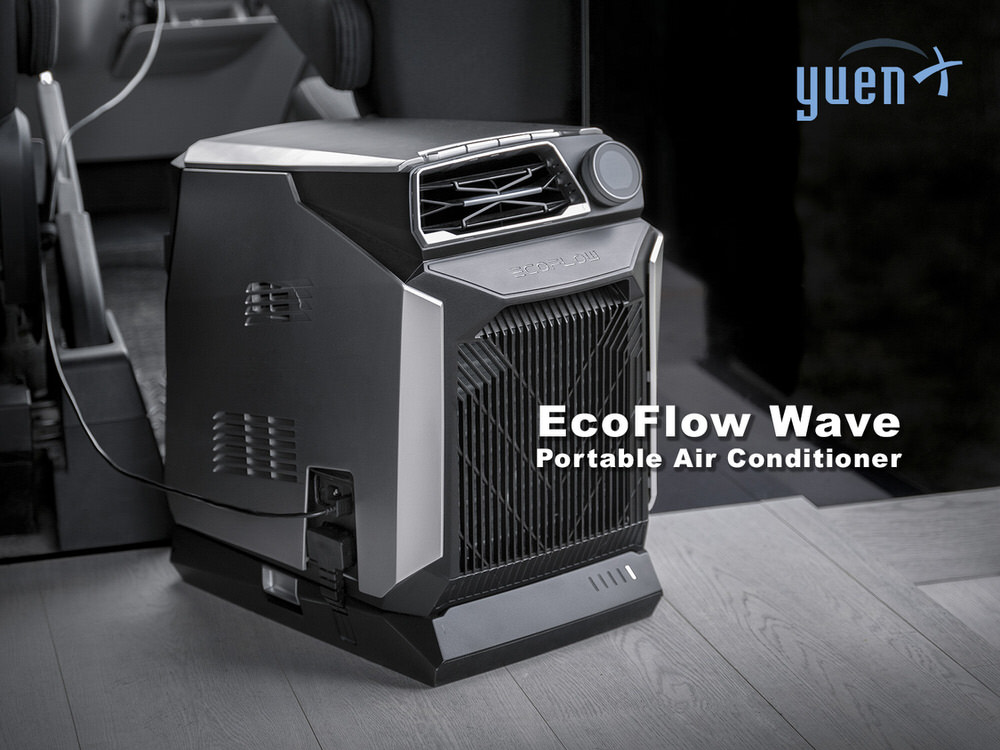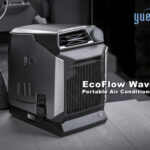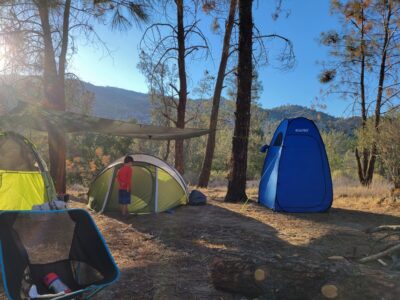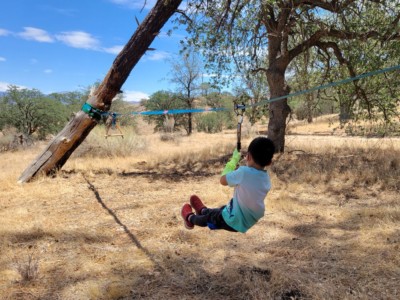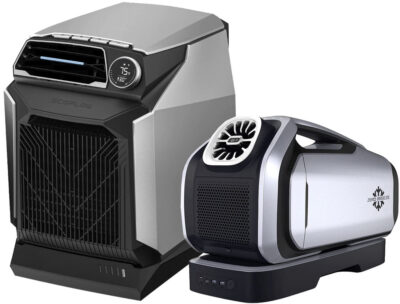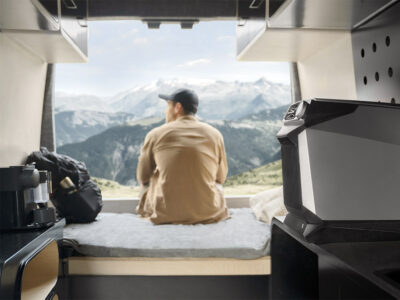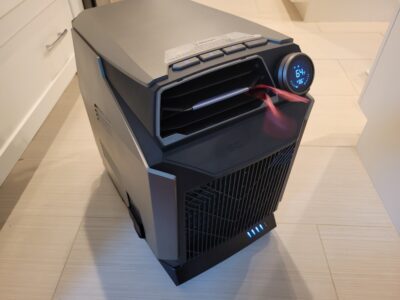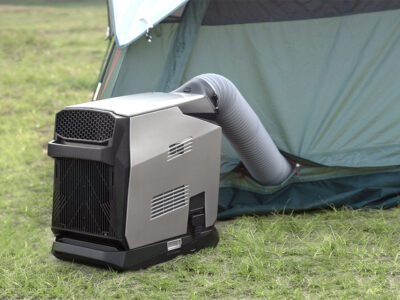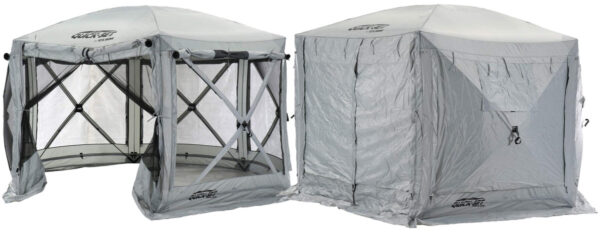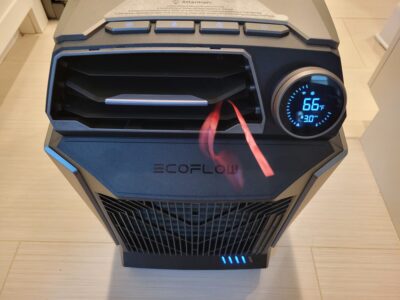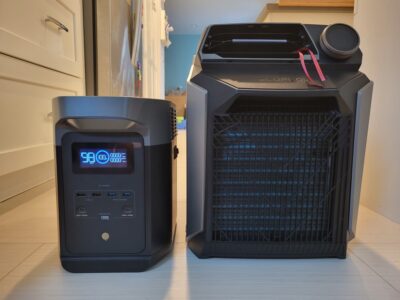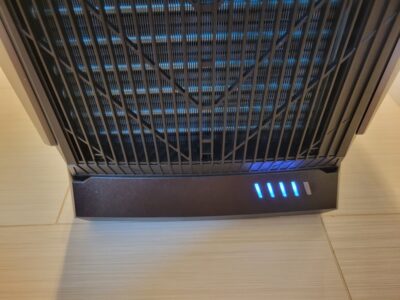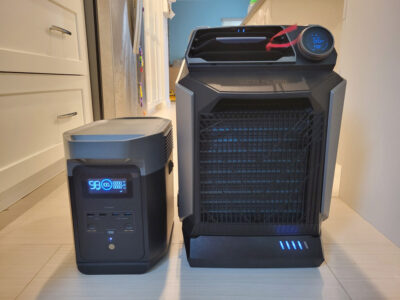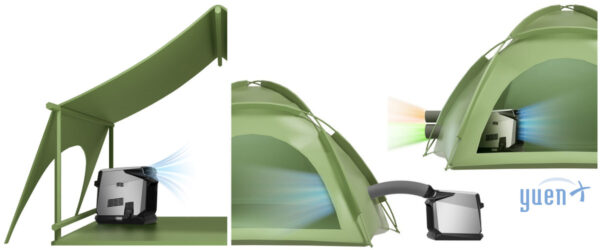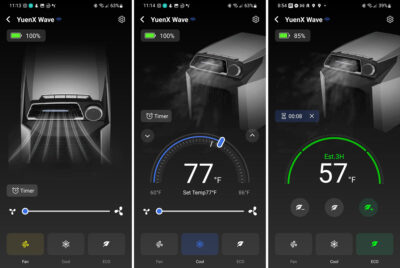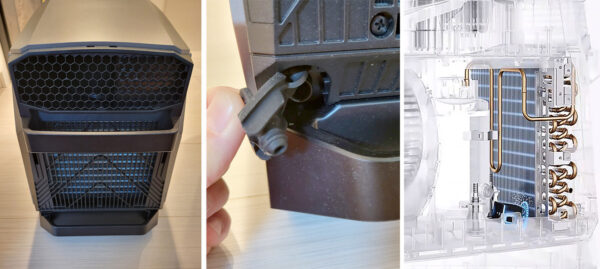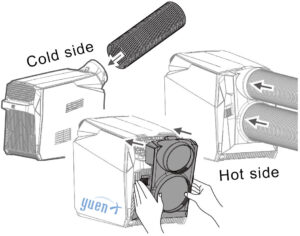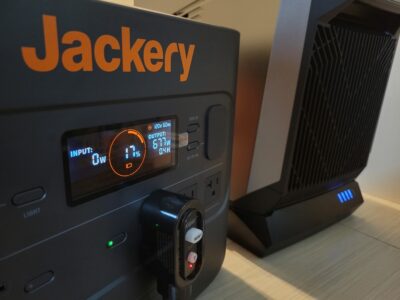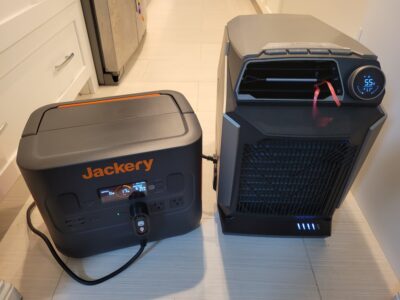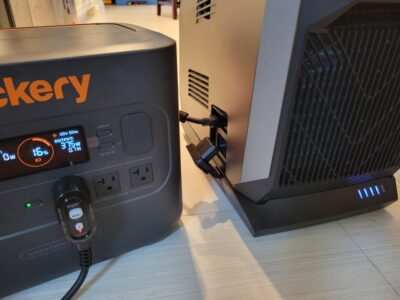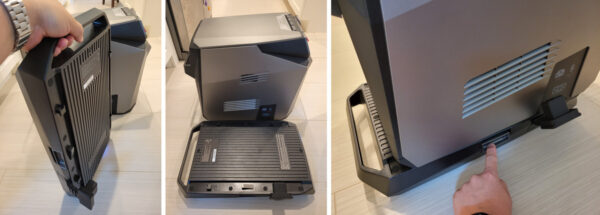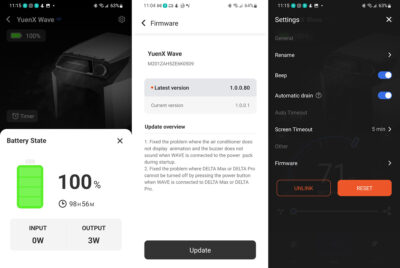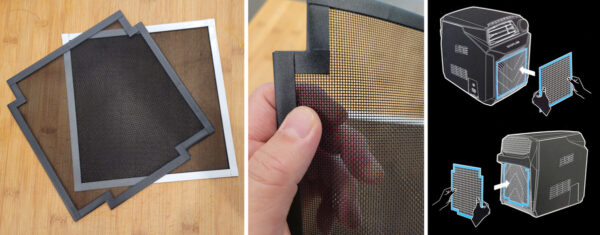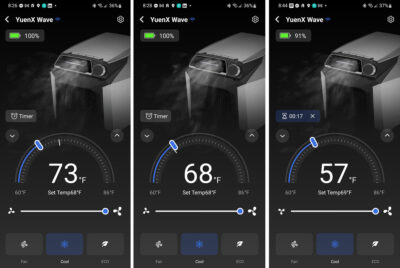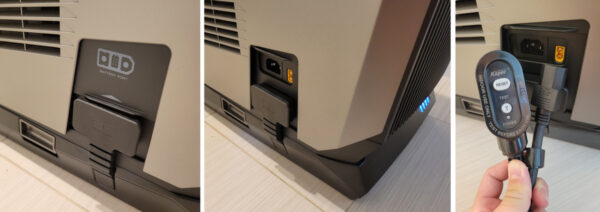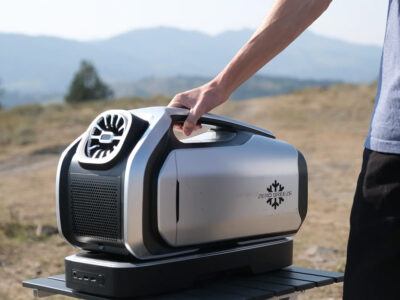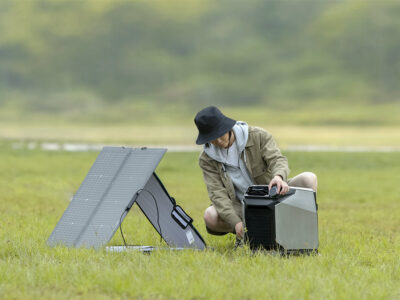EcoFlow Wave Portable Air Conditioner with Battery
Pros
- Excellent output and battery runtime
- Expansion options
- Can be used while charging
- Smartphone app control
- Condensate evaporation
Cons
- Odd ambient temperature reading
- Large and heavy
- Air filters were an afterthought. Mesh gap too large
- Defaults back to Celsius degrees (Fixed 6/5/2023)
- No left/right fan oscillation
Contents
Heat Relief
The COVID-19 pandemic that started in early 2020 triggered a number of consumer behavior changes, including a pent-up demand in outdoor activities, travel, and survival preparation. Sales of portable power stations, solar panels, guns, and recreational vehicles (RVs, vans, SUVs, minivans, etc.) skyrocketed over the subsequent years. There also was an emerging need for air conditioning both at home and while on the road — something my friends and I could attest to on July 3, 2021, when the afternoon and evening heat was so unbearable at a Southern California lake, we cut our camping trip short after just one evening.
Cold fruit and drinks that were cooled by a couple of our car freezers provided some relief, but my son and I wished that air conditioning for our tent was available. The two fans we had running hardly helped us stay cool enough to comfortably sleep until very late in the evening.
Swamp Cooler vs Air Conditioner
I looked into portable cooling units and found swamp (evaporative) coolers and the popular Zero Breeze Mark 2 air conditioner as options. The former was dismissed because even though they use far less energy, all they do is add moisture into the air and could potentially be unhealthy with increased risk of mold or mildew growth. They work best in dry areas and are useless in humid environments. Air conditioners, on the other hand, remove moisture, blow temperature-controlled air, maintain predictable cooling, but use a lot of energy. They turn air moisture into liquid that gets expelled through a drain. Another cooling method is an ice reservoir where ice must constantly be added to a water tank. No, thank you, to that one.
Evaporative (swamp) coolers add moisture to air as a way to lower the temperature in dry environments, air conditioners remove moisture and blow temperature-controlled air, and ice reservoirs fan cooled air through a constant supply of ice and water.
Portable Air Conditioners
Since a portable AC at over $1,500 was a luxury item for camping or boondocking/overlanding, I temporarily discontinued my research until an ad announcing the EcoFlow Wave, the company’s first appliance, came across on social media.
It piqued my interest as we had JUST completed our review of the excellent EcoFlow Delta Pro power station and 220W Bifacial Solar Panel for our vacation home. The company’s engineering, technology, and innovation were impressive. So much so, the Delta Pro had me second-guessing Goal Zero’s leadership with their older Yeti 1500x power station. EcoFlow’s newest Delta 2 battery (1,024Wh) with its 1,200W rapid charging further underscored that feeling. I monitored the news channels for a Wave price and features announcement, then decide whether to get an AC for overlanding, and if so, which one.
To much our delight, EcoFlow contacted us two months after our Delta Pro review was published and shared how much they liked the article. They asked if we would like to evaluate their upcoming Wave — yes, of course! But we would only do so under one condition: that they cannot influence any part of our review, whether good or bad. They agreed to our terms.
Disclosure: We received this product free in exchange for an honest, unbiased opinion, whether positive or negative. We test each product thoroughly, give high marks to only the very best, and the views expressed here are honest and our own. Learn more
In this review, we will be comparing the EcoFlow Wave and Zero Breeze Mark 2, and why I would recommend one over the other. Please do note that as of this writing, I had come across an ever-growing list of up-and-coming portable air conditioners geared towards outdoor enthusiasts and van lifers. I have been very much encouraged by this increase in competition as California temperatures have steadily been rising and made summer camping unbearable in large areas of the State.
We love using the Mr. Heater Buddy or Outland Living Firebowl inside a canopy tent with all its sides covered. Just be sure to leave an opening for air to circulate through to minimize the risk of carbon monoxide poisoning. We also use the tent with the EcoFlow Wave Portable AC to keep cool. Our favorite canopies are Clam Quick-Set Pavilion and Axa AxplorOutdoor as both come with built-in side covers.
Analysis
The Zero Breeze Mark 2 had been one of the most popular, portable air conditioners available for the outdoor market. It was a compact, battery powered appliance to optimally cool a 25-40 sq ft space (according to the manufacturer) at a heat removal rating of 2,300 BTU/hour (674Wh). Its 840Wh Li-ion NCM battery was rated to last 3-5 hours on a single charge but was plagued by inadequate cooling for larger spaces and very hot environments. That sometimes required the Mark 2 to be pointed directly at individuals to be cooled. Some of the complaints my friends had about the Zero Breeze (ZB) was its inability to be used while charging its battery (without adding a $130 Power Extension Dock), condensate water spilling out when driving over bumpy roads, and a special cable needing to be purchased to recharge via solar panels. Alas, with hardly any competition around, it was pretty much the only game in town.
When EcoFlow (EF), a relatively new company with noticeable engineering chops, announced its Wave AC, people took note — me included. What could a power station/solar panel business possibly know about air conditioning? As it turned out, quite a bit but also with some newcomer blunders.
The EcoFlow Wave at 38.6 lbs weighed more than double the Zero Breeze Mark 2 (16.5 lbs) due in part to its slightly larger footprint and nearly twice as much cooling power at 4,000 BTU/hour (1,172Wh). The manufacturer claimed the capacity to be optimal for fast-cooling a four-person tent, RV, or small room up to 86 sq ft in size. It promised to more quickly cool a space, be rechargeable while in use, and — like refrigerators — rapidly evaporate condensate so no more spills would occur while driving. The latter, of course, would only hold true in environments that were not humid.
The Wave Add-On Battery (1,008Wh Li-ion NCM) increased the weight by an additional 17.4 lbs and provided 3-8 hours of independent power, whereas Breeze’s added 12 lbs (840Wh Li-ion NMC) for 3-5 hours of runtime.
EcoFlow Wave’s capacity and capabilities could significantly be expanded with the company’s ecosystem of power stations and solar panels.
You may use the BTU Calculator to “estimate the cooling needs of a typical room or house”. Keep in mind that various factors could affect the estimate, including number of persons and amount of insulation and direct sun exposure. For instance, a tent has far less efficient insulation than a house and would require relatively more BTUs.
Cooling Tests
EF Wave had four operating modes: Cooling, Eco, Fan, and Timer. ZB Mark 2 also had four: Cooling, Sleep, Fan, and Rocket.
- EF Eco: Extended runtime through automatic switching between Cooling and Fan
- ZB Sleep: Extended runtime and reduced noise level
- EF Timer: Automatic shutoff after an elapsed time
- ZB Rocket: Maximum cooling at reduced runtime
My tests of the EF Wave in sunny 110F-degree weather at a partially exposed campsite found adequate, comfortable relief for my family of five inside the Core Instant Cabin 9-person tent. My Casio Pro Trek PRW2500T solar watch registered 78F at the center of the tent within half an hour of the Wave set to 68F and an additional fan to help circulate the air. Better insulation could certainly have helped more, but a 32F difference from the outside was very welcome nonetheless! I found my children sitting right next to the AC, enjoying their watermelon, and… chilling. The temperature range could be set to between 60.8F – 86F (16C – 30C). Reviews on the web found many complaints about the Zero Breeze not performing well in warmer weather.
Set the portable air conditioner to Eco or Sleep Mode to significantly extend the unit’s battery runtime for a longer cooling period.
With temperature dialed to 72F degrees, Eco Mode turned on, and Timer set to shut off by midnight, the 1,008Wh EF Wave Add-On Battery lasted us two nights with about 10% capacity remaining. Eco Mode periodically switched between AC and Fan to extend runtime to approximately 8 hours and could only be activated through the app. Otherwise, it could only last 3 hours in AC-only mode in 78F ambient temperature, EcoFlow noted. There were Low, Medium, and High settings for Eco Mode, with the latter providing the most battery saving.
Condensate/Water Drainage
Hardly any condensate could be observed during the test period. EcoFlow’s website cautioned that high humidity environments (70%+) may find excess water building up, requiring it to be emptied through the rear drain hole. In lower-humidity areas like the Southern California summers, no such maintenance was required since the Wave sprayed excess water onto “the internal [hot] condenser to evaporate”. Zero Breeze required constant draining even in low humidity. A 3.3′ long drainage tube (0.71″ diameter) was included with the Wave. When draining, the battery should be disconnected to minimize the risk of any damage that could result.
Intake/Exhaust Ducts
The included ducts allowed the Wave to be operated from either inside the living space or outside. Obviously, if it was left running outside the tent, there would be a risk of getting it wet or dusty — or stolen if not properly secured. We were at one point able to split the output hose into two to cool down two tents.
You may consider getting a window kit with seal plates to secure hoses with, such as one from Gulrear (for 5.0″ and 5.9″ diameter hoses). Alternatively, save the foam packaging that came with the Wave as it could be cut to size to route the hot exhaust hose through. It made for a sturdy, free bracket.
Two 3.3′ (39.37″) long ducts were included: 6.3″ and 5.12″ diameters.
Power and Runtime
I was happy to find the Wave compatible with the company’s own Delta Pro, Delta Max, and Delta 2 power stations and their respective, extra batteries. Why would that be significant? When used with those power stations or add-on batteries, the Wave’s capacity extended far beyond what the Zero Breeze Mark 2 could offer: rapid charging by AC or DC (while continuing to cool at the same time), faster solar input, and increased battery capacity by as much as 3,600Wh with the Delta Pro or its DP Add-On Battery. The latter would allow the Wave to run 3-4 times as long on a single charge… up to 32 hours in Eco or 12 hours in AC-only Mode! Also of note is that when directly connected to the EF Deltas’ DC port instead of AC, power efficiency improves by about 25% since the inverter no longer adds a 7W drain. Nicely done, EcoFlow!
Charging. As I had mentioned, the Wave could still be used while its Add-On Battery was simultaneously being recharged. The Add-On Battery could not be charged without being connected to the Wave. The Jackery Explorer 2000 Pro (See our Review) appeared to directly charge the battery at 676W while the powered-on Wave continued to draw from its Add-On Battery. The standalone Wave drew 375W without its Add-On Battery attached. Similarly, when the Wave was turned off while the Add-On Battery was attached, the Jackery still registered a 675W output. What did all that mean? The Add-On Battery required at least 600W to charge whether the air conditioner was on or off. As such, the power station must be capable of providing at least that level of output, and if it did not, the Add-On Battery must be disconnected from the Wave in order to continue operating the air conditioner as a standalone unit at 375W.
EcoFlow noted on their website that only Fan Mode would work if the solar panels or car charging cable were incapable of providing sufficient power for the compressor. Both solar (11-35V, 12A max) and car (12V/24V, 8A max) inputs, according to the manual, were capped at 200W and short of the approximately 330W required by the Wave, and far short of the 600W by the Add-On Battery. I forgot to test how much power was drawn in Fan mode.
Wave Add-On Battery could not be independently charged. It must be connected to the air conditioning unit to recharge.
Whenever possible, always power the EF Wave with DC instead of AC. That would give you up to 25% more efficient runtime since there would be no energy loss from AC-to-DC conversion. To do so, hook up the Wave with the EF Delta Pro, Delta Max, Delta 2, or any of their Extra Batteries using the corresponding Extra Battery Cable and/or Delta Pro-to-Smart Generator Adapter
In a nice touch for safety, the Wave’s power cable has LCDI protection – Leakage Current Detection and Interruption.
Check it out!
Ultimate Reference: Power Station Comparison – We summarized the specifications of many of the power stations we had come across or reviewed all in one place.
Video: Quick Look and Power Tests
Here is a video where we take a brief look at the features and test the Wave’s power usage with its Wave Add-On Battery. We then proceeded to connect it to the Jackery Explorer 2000 Pro’s AC port and the EF Delta 2 Extra Battery’s more efficient DC output.
Cost and App Control
Price wise without their respective add-on battery, the Wave commanded a $200 higher premium than the Mark 2. But, considering the additional features available with the EcoFlow unit — and its ability to interface with the company’s other products — made the Wave more appealing to us.
EcoFlow’s smartphone app (available for both Apple iOS and Android) was the same one used with the Delta power stations. It communicated with the Wave via Bluetooth or WiFi and provided a visual representation of the battery capacity, various features and configurations, and firmware updates. Zero Breeze’s unit did not support a mobile app due to its lack of WiFi and Bluetooth.
Gripes
EcoFlow seemingly did not plan the Wave with an air filter in mind to keep dust and debris out of its intake vent. Instead, at a shipped cost of $7, the company later made two plastic air filters available to be taped onto the exterior chassis — an afterthought likely added from customer feedback. One would go on the front and one on the back. They would not be reusable or washable without having to replace the double-sided tape. Furthermore, the filter’s mesh spacing was too large and would not stop dust or pollen from passing through. Rookie mistake? I am not sure what went behind the engineers’ thought process as all that looked like blunders to me, but I am sure they are smarter than me when it came to HVAC systems.
I would have liked the air “filters” lined with an actual filter material (like those found with home air conditioning systems) and be easily removable with a sliding or storage mechanism. The Wave was neither water nor dustproof, making the air filters play an even more important role in maintaining reliability and longevity. One could attach a 3M Air Filter with a bungee cord in dusty environments like campsites.
When setting the Wave to cool at a desired temperature like 68F, for example, the control knob (and app) would strangely show 68F a few minutes later even though the surrounding was still 78F. In another instance, temp was set to 69F, ambient was 70F, but the Wave measured 57F after 18 minutes (or 9% battery used) — colder than the 69F I had configured. Where were those readings taken from? Inexplicably, the vent where the cool air was blowing through. That meant that the set temperature would not always match the surrounding air’s. Nonetheless, the small bedroom did cool down a considerable number of degrees lower due to the Wave’s strong air flow and high heat-removal rating.
EcoFlow Wave had some odd issues likely stemming from its new entry into the portable air conditioner market. Be sure to always update to the latest firmware via the EcoFlow app for enhancements and bug fixes.
Additional, minor issues were found. The temperature display unit defaulted back to Celsius after powering off, and one must long-press the Temperature button to switch back to Fahrenheit. [Update 6/5/2023: A firmware update fixed this.] The cool air vent could only be adjusted to blow up or down, but not horizontally (or oscillating) to the left and right. As I had previously stated, Eco Mode could only be managed from the app and not on the unit directly.
One review I came across noted the Wave unit itself getting very hot along the sides and top after a prolonged time despite having the heat vented out of the vehicle. I had not experienced that issue. The sides were cool to the touch, and the top was a very mild warmth. Perhaps a firmware update addressed any such issue as I had always ensured my unit’s software was up-to-date.
No protective carry bag was available nor planned for at the time of this writing.
Conversion: BTU to/from Watt-Hour
To convert between Watt-Hours and BTU/hour, use the following equations:
- BTU/hour to Watt-Hours
- Wh = BTU / 3.412141633 (or) Wh = BTU * 0.29307107
- Examples
- 4,000 BTU/hour = 1,172Wh. Calculation: Wh = 4000 BTU / 3.412141633 (or) 4000 BTU * 0.29307107
- 2,300 BTU/hour = 674Wh
- Watt-Hours to BTU/hour
- BTU = Wh * 3.412141633 (or) BTU = Wh / 0.29307107
- Examples
- 1,172Wh = 4,000 BTU/hour. Calculation: BTU = 1172Wh * 3.412141633 (or) 1172Wh / 0.29307107
- 674Wh = 2,300 BTU/hour
Portable AC Comparison
| Product | Thermal Energy | Optimal Room | Power Used | Battery Capacity | Battery Runtime | Charge While In Use | MSRP | Solar | WiFi, BT | Base Weight | Dimensions (inches) |
|---|---|---|---|---|---|---|---|---|---|---|---|
| EcoFlow Wave | 4,000 BTU 1,172 Wh | 86 sq ft | 330W+ | 1,008Wh NMC* | 3-8h AC* | Yes | $1,200 +$600 Battery | Yes | Yes | 38.6 lbs +17.4 lbs Battery | 20.4 x 12.2 x 16.4 |
| Zero Breeze Mark 2 | 2,300 BTU 674 Wh | 40 sq ft | 240W+ | 840Wh NMC | 3-5h AC | Yes. Dock | $1,000 +$500 Battery | Yes | No | 16.5 lbs +12 lbs Battery | 11 x 10 x 20 |
* EF Wave: Cooling runtime could be extended up to 32h max with a 3,600Wh Delta Pro or Delta Pro Extra Battery.
Final Thoughts
Taking all features, factors, and cost into consideration between the Zero Breeze Mark 2 and EcoFlow Wave, the latter had been much more capable in rapid cooling performance, expandability, and modern feature sets. The Zero Breeze, however, might be a better choice for those with smaller spaces and fewer persons to cool, desired lighter weight, and/or wanted something with less power consumption.
Personally, because we already had EcoFlow Delta, Goal Zero Yeti X, and Jackery Explorer power stations and solar panels, our choice clearly had been the Wave because it could cool much faster, accommodate a larger space, and could be used while charging. The Zero Breeze would require the purchase and periodic swapping of an additional battery for continuous operation. Thus, with a 2nd set of batteries, the Zero Breeze would cost $150 more, only save 15 lbs, but provide 672Wh more capacity over the Wave and its Add-On Battery.
Our recommendation went to the EcoFlow Wave for larger spaces, especially for those who already had EcoFlow Delta power stations to expand both capacity and capabilities with.
Tip: We LOVE pairing a canopy tent with side panels (Clam or Axa) with the Outland Living Firebowl or Mr. Heater Buddy to retain heat during the winter; or to keep cool with the EcoFlow Wave Portable AC.
Where To Buy
- EcoFlow Portable AC: Wave (AC) / Wave 2 (AC and Heater)
- EF Wave Add-On Battery / Wave 2 Add-On Battery
- Pairable with:
- EF Delta Pro – See our Review / EF Delta Pro Extra Battery
- EF Delta Max / EF Delta Max Extra Battery
- Zero Breeze Mark 2 Portable Air Conditioner
- ZB Mark 2 Add-On Battery / Solar Cable
- Power Dock (for simultaneous battery charging and AC use)
- Gulrear Window Kit (for 5.0″ and 5.9″ diameter hoses)
- Power Stations
- EcoFlow Delta Pro / Max
- Goal Zero Yeti
- Jackery: Explorer 2000 Pro – See our Review / Explorer 1000 – See our Review
- Canopy Tent with Side Panels
- Built-in Panels: Clam Quick-Set Pavilion / Axa AxplorOutdoor
- Separate Panels: MasterCanopy + five panels (not available for door)
- Core Instant Cabin 9-Person tent – See our Review
- Casio Pro Trek PRW2500T solar watch
Related Posts
- Temperature Control
- Mr. Heater Buddy Indoor-Safe Portable Propane Radiant Heater
- Outland Living Firebowl Propane Fire Pit (893 Deluxe) with Refillable Tank
- Power Stations
- EcoFlow: Delta Pro
- Goal Zero vs Jackery: Yeti 1000 Core vs 1000X vs Explorer 1000
- Goal Zero Yeti 1000x / Yeti 500x
- Jackery Explorer 2000 Pro / Explorer 1000 / Explorer 300
- Bluetti EB70S LiFePO4
- Solar Panels
- EcoFlow: 220W Bifacial / Goal Zero: Nomad 200 / Jackery: SolarSaga 100W
- Lighting
- Devos LightRanger 2000 vs 1200: Bright, portable, compact, full-coverage area light with battery and stand. Now brighter with remote control, built-in colored LEDs
- Devos LightRanger 1200: Portable, compact, full-coverage area light with battery and stand
- Goal Zero Skylight: Heavy-duty, bright, portable, full-coverage area light with battery and stand
- Quick Look
- Announcements
- Car Freezers

